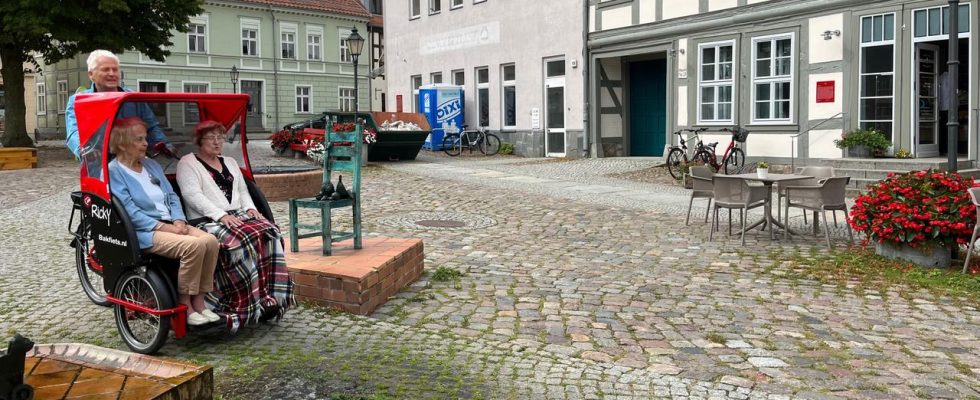Many East German cities have been renovated since the 1990s. In Angermünde in Brandenburg, the city center is now a listed building. But the cobblestones are a problem for many seniors.
“Are you still coming alone or should I help?” Frank Krüger asks the two over 80-year-olds in front of the “Am Stadtwall” senior citizens’ center run by the Arbeiterwohlfahrt in Angermünde. The volunteer lifts Karin Goebels and Ute Heese from their wheelchairs into a rickshaw to drive them through the historic old town. Because otherwise the senior citizens find it difficult to get out of their home, for example to the supermarket. The 93-year-old Horst Gerlach accompanies them on one of the electric vehicles.
The cobblestones are an insurmountable obstacle for many seniors. Even with a walker and mobility scooter, it is difficult for people with walking disabilities. “My legs don’t take it and so I have the opportunity to go there and buy something that isn’t available here. Or I stand on the street and always wait for someone who knows me to come by.” , says Gerlach. “A little freedom.” But high curbs set seniors further limits. “You’re always afraid of tipping over, because then you lie on your back like a beetle and can’t get up again,” says the home resident.
Center listed historical monument
The rickshaw reaches the Angermünde market square. “Today there is not much going on here on the market,” says Krüger while pedaling. “The weather isn’t great either.” Nevertheless, the seniors enjoy the trip. “I can’t do it alone,” says home resident Goebels. “It’s just not possible – even through the paths that are so horrible.”
Like many East German cities, Angermünde has been extensively renovated since the early 1990s – thanks to subsidies. They are earmarked for 25 years. The historic center is now a listed monument. Remodeling for the elderly is currently not possible.
The historic city center of Angermünde is a listed building – but is not suitable for seniors.
paradigm shift 15 years ago
“It’s a problem that a city like Angermünde has made everything nice and chic, but can’t open everything up again now,” admits the head of the office of the German National Committee for Monument Protection, Ulrike Wendland. Cities like Quedlinburg and Neuruppin also have many protected monuments.
A paradigm shift only began 15 years ago. “It’s much more about inclusion, so it’s also about young people, the visually impaired and the elderly,” explains the art historian. In addition, climate change plays a bigger role today. Water should drain off better, the soil should absorb more.
Ursula Schirmer, Head of the Awareness Raising Department at the German Foundation for Monument Protection, emphasizes the ecological factor. In addition, residents have complained about noise caused by the cobblestones. In addition, market traders could not set up their tents and stalls there because there were no herring.
“Back then, people didn’t think of people with disabilities, but of women with high heels,” explains the preservationist, looking back at the 20th century. However, there are now ideas. “If the main surface is paved, walkways with granite slabs on the edge or crisscrossing can be created today,” says Schirmer. “You can get over this with any cane and high-heeled shoes.”
The 93-year-old Horst Gerlach drives in front of the senior center “Am Stadtwall” in Angermünde on an electric vehicle.
“Everyone has to decide”
Monument preservationists only formulated goals, adds Wendland. “It is in the hands of the cities, municipalities and districts,” says the head of the office of the German National Committee for Monument Protection. “If there is a conflict, they can decide against the votes of the monument authorities. Everyone has to weigh things up – and those who preserve monuments give each other a push.”
Angermünde’s deputy mayor explains that his city cannot simply change the cobblestones. “But of course we’re trying to find other ways to let older people in particular participate in life,” says the non-party politician.
That is why the city, with partners and funding from the state, has, among other things, purchased an electric vehicle with larger wheels. “Here we have our horn. Once on the left. Once on the right,” explains Jens Kuschel, the moderator of the Angermünde nursing regulars’ table, to the pensioner Wolfgang Zeiler in front of the “Am Stadtwall” senior center. It toots loudly. “And we have different switch-on levels here, where the number of kilometers is then throttled. Level one we drive up to 10 km/h, level two up to about 15 km/h and level three then up to 25.”
No risk for over 80-year-olds, who sometimes react more slowly, says Kuschel: “It’s not dangerous at first, we have the throttle to 10 km/h with this toggle switch, so that the seniors can’t escape us completely.”
The rickshaw ride by Karin Goebels and Ute Heese ends at the Mündesee in the Uckermark.
Not everyone likes electric vehicles
At the city wall in Angermünde, some seniors turn up the heat during their first ride. “This is a premiere,” says home resident Manfred Skrypzak. “Great, I like that.”
But not everyone likes the electric vehicles on the cobblestones. “I thought, where do you drive it – on the sidewalk or on the street?” Karin Goebels asks. “I don’t know if that’s a good thing.” The resident of the senior center prefers the rickshaw, which the volunteer also benefits from. “You have to move in old age,” says Frank Krüger. “If I go to the gym for an hour, it costs me a few marks and that’s how I warm up here.”
Resident Goebels emphasizes how important the excursions are to her: “First, see something different and get some fresh air – and it’s just wonderful.” Your trip ends at the Mündesee in the Uckermark, where the seniors would not have made it on their own.

